Communist Party of India (Marxist), Kerala | |
|---|---|
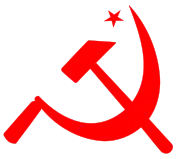 | |
| Secretary | M. V. Govindan |
| Headquarters | "A. K. G. Bhawan", Thiruvananthapuram |
| Student wing | Students Federation (SFI Kerala) |
| Youth wing | Democratic Youth Federation (DYFI Kerala) |
| Women's wing | Democratic Women's Association (AIDWA Kerala) |
| Labour wing | Centre of Indian Trade Unions (CITU) |
| Membership | 5,27,174 (2021) |
| Ideology | Communism |
| Political position | Left-wing[1] |
| Alliance |
|
| Seats in Lok Sabha | 1 / 20 (Kerala) |
| Seats in Rajya Sabha | 4 / 9 (Kerala) |
| Seats in Kerala Legislative Assembly | 62 / 140 |
| Election symbol | |
_election_symbol_-_Hammer_Sickle_and_Star.svg.png.webp) | |
| Party flag | |
 | |
| Website | |
| cpimkerala | |
The Communist Party of India (Marxist), Kerala or CPI(M) Kerala is the Kerala state wing of CPIM. It is responsible for organizing and coordinating the party's activities and campaigns within the state, as well as selecting candidates for local, state, and national elections. Currently, it is the governing party in the Kerala Legislative Assembly and has significant representation of the state in Rajya Sabha.[2] The CPIM currently leads the LDF alliance.
History
Background
In July 1937, clandestine meeting held at Calicut.[3] Five persons were present at the meeting, P. Krishna Pillai, K. Damodaran, E.M.S. Namboodiripad, N. C. Sekhar and S.V. Ghate. The first four were members of the Congress Socialist Party (CSP) in Kerala. The Communist Party of India in Kerala was formed on 31 December 1939 with the Pinarayi Conference.[4]
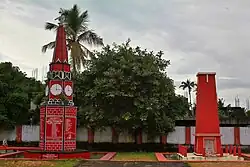
In 1946, Punnapra-Vayalar uprising was a mass communist movement against C. P. Ramaswami Iyer, the Diwan (Head) of Travancore in Alappuzha. The revolt was due to over 21,000 peasants died in Cherthala taluk alone during the Famine (1939–43). This led to a war between the Travancore police and people. Over 400 people were killed. After the killings, many people around the areas turned into communists.[5]
In 1957 Kerala Assembly election the Communist Party of India (CPI) was elected to rule the state government of Kerala under E. M. S. Namboodiripad only to have the government dismissed and President's Rule declared in 1959 following the Vimochana Samaram. In 1964, in conjunction with the widening rift between China and the Soviet Union, a large leftist faction of the CPI leadership, based predominantly in Kerala and West Bengal, split from the party to form the Communist Party of India (Marxist), or CPI (M). In Kerala, the CPI (M) in coalition with other parties wrested control from the Congress and its allies (frequently including the CPI) in 1967, in 1980, and in 1987. Support for the CPI (M) in Kerala in general elections has ranged from 19 percent to 26 percent, but the party has never won more than nine of Kerala's twenty seats in Parliament.
Formation of CPI(M) in Kerala
_Leaders._Noormahal._27_Oct_1966.jpg.webp)
After the CPI split in 1964, prominent communist leader in Kerala E.M.S. Namboodiripad, A. K. Gopalan and K. R. Gouri Amma stood with the Communist Party of India (Marxist). One year after the split, in the 1965 elections CPI(M) which was splinter faction of CPI, emerged as the largest party in the assembly with 40 seats. Where CPI settled with 3 seats only. However no single party could form a ministry commanding majority and hence this election is considered abortive. President's rule was invoked for the fourth time.[6][7]
In the 1967 Kerala assembly election both communist parties - CPI (M) and CPI - along with smaller parties including SSP and Muslim League contested this election as a United Front. A total of seven parties contested in the front, and the front was known as Saptakakshi Munnani.[8] The CPI(M) led front won the election with a record 113 seats out of 133 seats and formed the government under E.M.S. Namboodiripad.[9] After 2 years of the government, due to continous problems between CPI and CPI(M) many ministers from the smaller parties resigned eventually, and many parties subsequently left the front owing to the loss of majority the Second Namboodiripad ministry was disolved in 1969.[10]
Emergency rule in Kerala
During the emergency rule, when communists in Kerala were organising the political activities from different hide-outs, many CPI(M) members and leaders including current chief minister of Kerala Pinarayi Vijayan was imprisoned for one and a half years. He was arrested and tortured by police.[11] After his release, Pinarayi Vijayan reached the Kerala Legislative Assembly and made an impassionate speech against senior Congress leader K. Karunakaran holding up the blood-stained shirt he wore when in police custody, causing serious embarrassment to the then C. Achutha Menon government.[12] Hundreds of Communists, whether from the CPI(M), other Marxist parties, or the Naxalites, were arrested during the Emergency.[13] Some were tortured or, as in the case of the Kerala student P. Rajan, killed.[14][15]
Formation of Left Democratic Front alliance
In the late 1970s and early 1980s, two main pre-poll political alliances were formed: the Left Democratic Front (LDF), led by the Communist Party of India (Marxist) and Communist Party of India and the United Democratic Front (UDF), led by the Indian National Congress.[16]
Nayanar Era (1980 - 2001)

Since the formation of the alliance in 1980, E. K. Nayanar has led the party and alliance for two decades and has also became the longest-served Chief Minister of Kerala.[17] The CPI(M) led alliance has won every alternate election in 1980 election, 1987 election and 1996 election since the formation led by Nayanar.[18] In this period Kerala saw several progressive reforms, especially in the Land Reforms and Labour Welfare sectors. The Kerala Coir workers Welfare Fund Act, 1987, The Kerala Khadi Workers’ Welfare Fund Act, 1989, The Kerala Abkari Workers Welfare Fund Act, 1989, The Kerala Construction workers’ Welfare Fund Act, 1989 and the Kerala Ration Dealer’s Welfare Fund Act 1998.[19]
Timeline
- 1925 - Workers and Peasants Party formed which later helped to form Communist Party of India.[20]
- 1925 - Communist Party of India founded in Kanpur on 26 December 1925.[21]
- 1931 - Communist League formed for propaganda for organising a trade union in Trivandrum, Kerala, in 1931
- 1934 - Formation of Congress Socialist Party (CSP) in Kerala, as part of the Popular Front strategy of the ComIntern.[22]
- 1935 - All India member of Communist Party of India, P. Sundarayya met members of CSP Kerala unit leaders P. Krishna Pillai and E.M.S. Namboodiripad in Madras.[23]
- 1937 - A meeting was held in Calicut between P. Krishna Pillai, E.M.S. Namboodiripad, A. K. Gopalan, K. Damodaran, N. C. Sekhar and S.V. Ghate whom were members of Congress Socialist Party (CSP)
- 1939-40 - Split in Congress. Communist Party of India walked away with the entire Kerala Congress unit.[24]
- 1940 - Formation of Communist Party of India in Kerala
- 1946 - Punnapra-Vayalar Revolt, was a mass communist movement against C. P. Ramaswami Iyer, the Diwan (Head) of Travancore[25]
- 1947 - India gains independence from British Raj.
- 1952 - In the 1952 Travancore-Cochin Legislative Assembly election, Communist Party of India was banned to contest election.[26]
- 1956 - Kerala state was formed comprising South Canara (Kasaragod region), Malabar, Cochin, and Travancore.[27]
- 1957 - First Kerala Legislative assembly election was held in Kerala, the election led to the formation of first democratically elected communist government in India and first state to elect a Non-Congress party in the country.[28] E.M.S. Namboodiripad sworn in as first chief minister of Kerala.[29]
- 1959 - Dismissal of government following Liberation Struggle.[30]
- 1963 - Split in leadership of Communist Party of India (CPI).
- 1964 - Formation of Communist Party of India (Marxist) (CPI(M)).[31]
- 1967 - CPI(M) led United Front Alliance won the Forth Kerala Legislative assembly election with over 113 of 133 seats. The alliance included CPI and Muslim League.
- 1980 - Formation of CPI(M) led Left Democratic Front (LDF) alliance.
Structure and composition
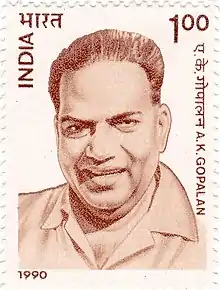
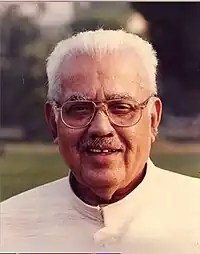
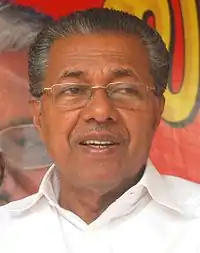

List of state secretaries of CPI(M) Kerala
| No. | Secretary | Term | Total Years as secretary |
|---|---|---|---|
| 1 | C.H. Kanaran | 1964–1972 | 8 Years |
| 2 | E. K. Nayanar | 1972–1980 | 8 Years |
| 3 | V. S. Achuthanandan | 1980–1992 | 12 Years |
| 4 | E. K. Nayanar | 1992–1996 | 4 Years |
| 5 | Chadayan Govindan | 1996-1998 | 2 Years |
| 6 | Pinarayi Vijayan | 25 September 1998 – 23 February 2015 | 17 Years |
| 7 | Kodiyeri Balakrishnan | 23 February 2015 – 28 August 2022 | 7 Years |
| 8 | M. V. Govindan | 31 August 2022–present | Incumbent |
List of Polit Bureau members from CPI(M) Kerala
| No. | Name | Period |
|---|---|---|
| 1 | E. M. S. Namboodiripad | 1964 - 1998 |
| 2 | A. K. Gopalan | 1964 - 1977 |
| 3 | E. Balanandan | 1978 - 2005 |
| 4 | V. S. Achuthanandan | 1986 - 2009 |
| 5 | E. K. Nayanar | 1992 - 2004 |
| 6 | S. Ramachandran Pillai | 1992 - 2022 |
| 7 | Pinarayi Vijayan | 1998–present |
| 8 | Kodiyeri Balakrishnan | 2008 - 2022 |
| 9 | M. A. Baby | 2012–present |
| 10 | M. V. Govindan | 2022–present |
| 11 | A. Vijayaraghavan | 2022–present |
Current State Secretariat Leaders
Source:[32]
| No. | Leader's name | Born (Age) |
|---|---|---|
| 1 | Pinarayi Vijayan | 24 May 1945 |
| 2 | A. K. Balan | 3 August 1948 |
| 3 | P. K. Sreemathy | 4 April 1949 |
| 4 | E. P. Jayarajan | 28 May 1950 |
| 5 | T. P. Ramakrishnan | 15 June 1950 |
| 6 | T. M. Thomas Isaac | 26 September 1952 |
| 7 | M. V. Govindan | 23 April 1953 |
| 8 | V. N. Vasavan | 3 March 1954 |
| 9 | K. N. Balagopal | 28 July 1963 |
| 10 | Saji Cherian | 28 May 1965 |
| 11 | P. Rajeeve | 13 May 1968 |
| 12 | P. K. Biju | 3 April 1974 |
| 13 | P. A. Mohammed Riyas | 18 May 1976 |
| 14 | M. Swaraj | 27 May 1979 |
Principal mass organisations
| No. | Organisation Name | Association for | President |
|---|---|---|---|
| 1 | Democratic Youth Federation of India (DYFI) | Youth | V. Vaseef |
| 2 | Students' Federation of India (SFI) | Students | P. M. Arsho |
| 3 | Centre of Indian Trade Unions (CITU) | Trade union | Anathalavattom Anandan |
| 4 | All India Democratic Women's Association (AIDWA) | Women | P. K. Sreemathy |
| 5 | Balasangam | Children | B. Anuja |
| 6 | Bank Employees Federation of India (BEFI) | Bank | C. J. Nandakumar |
| 7 | Adivasi Kshema Samithi (AKS) | Tribal | K. C. Kunhiraman |
List of Chief Ministers from CPI(M)
| № | Portrait | Name Ministry (Year) |
Length of term | |
|---|---|---|---|---|
| Longest continuous term | Total years of premiership | |||
| 1 | _1.jpg.webp) |
E. M. S. Namboodiripad 1st Namboodiripad (1957–1959) 2nd Namboodiripad (1967–1969) |
2 years, 240 days | 4 years 357 days |
| 2 | 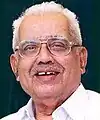 |
E. K. Nayanar 1st Nayanar (1980–1981) 2nd Nayanar (1987–1991) 3rd Nayanar (1996–2001) |
5 years, 27 days | 11 years, 10 days |
| 3 | 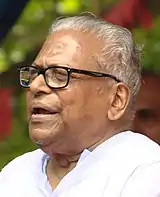 |
V. S. Achuthanandan Achuthanandan (2006–2011) |
4 years, 364 days | 4 years, 364 days |
| 4 | 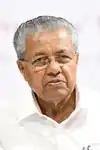 |
Pinarayi Vijayan 1st Pinarayi (2016–2021) 2nd Pinarayi (2021–present) |
7 years, 233 days | 7 years, 233 days |
Results in Kerala elections
| Year | Party leader | Overall votes | % of overall votes | Total seats | seats won/ seats contensted |
Change in seats |
Outcome | |||
|---|---|---|---|---|---|---|---|---|---|---|
| As Communist Party of India | ||||||||||
| 1957 | E. M. S. Namboodiripad | 2,059,547 | 35.28% | 126 | 60 / 101 |
Government | ||||
| 1960 | 3,171,732 | 39.14% | 126 | 29 / 108 |
Opposition | |||||
| As Communist Party of India (Marxist) | ||||||||||
| 1965 | E. M. S. Namboodiripad | 1,257,869 | 19.87% | 133 | 40 / 73 |
No Result | ||||
| 1967 | 1,476,456 | 23.51% | 133 | 52 / 59 |
Government | |||||
| 1970 | N/A | N/A | 133 | 29 / 70 |
Opposition | |||||
| 1977 | 1,946,051 | 22.2 % | 140 | 17 / 68 |
Opposition | |||||
| 1980 | E. K. Nayanar | 1,846,312 | 19.4% | 140 | 35 / 50 |
Government | ||||
| 1982 | 1,798,198 | 18.8% | 140 | 28 / 51 |
Opposition | |||||
| 1987 | 2,912,999 | 22.8 % | 140 | 38 / 70 |
Government | |||||
| 1991 | 3,129,523 | 22.1 % | 140 | 28 / 65 |
Opposition | |||||
| 1996 | V. S. Achuthanandan | 3,078,723 | 21.6 % | 140 | 40 / 62 |
Government | ||||
| 2001 | 3,361,827 | 21.4 % | 140 | 24 / 65 |
Opposition | |||||
| 2006 | 4,732,381 | 30.4 % | 140 | 61 / 85 |
Government | |||||
| 2011 | 4,921,354 | 28.2 % | 140 | 44 / 84 |
Opposition | |||||
| 2016 | Pinarayi Vijayan | 5,365,472 | 26.7 % | 140 | 58 / 84 |
Government | ||||
| 2021 | 5,288,502 | 25.5 % | 140 | 62 / 75 |
Government | |||||
Indian general elections results in Kerala of CPI(M)
| Year | Legislature | Party Secretary | Total constituencies | Seats won / contested | Change in seats | Total votes | Per. of votes | Change in vote % | Ref. |
|---|---|---|---|---|---|---|---|---|---|
| 1967 | 4th Lok Sabha | Puchalapalli Sundarayya | 19 | 9 / 9 |
New | 1,540,027 | 24.6 % | New | [33] |
| 1971 | 5th Lok Sabha | 19 | 2 / 11 |
1,711,442 | 26.2 % | [34] | |||
| 1977 | 6th Lok Sabha | 20 | 0 / 9 |
1,800,193 | 20.3 % | [35] | |||
| 1980 | 7th Lok Sabha | E. M. S. Namboodiripad | 20 | 7 / 8 |
1,754,387 | 21.5 % | [36] | ||
| 1984 | 8th Lok Sabha | 20 | 1 / 10 |
2,425,965 | 22.3 % | [37][38] | |||
| 1989 | 9th Lok Sabha | 20 | 2 / 10 |
3,411,227 | 22.9 % | [39] | |||
| 1991 | 10th Lok Sabha | 20 | 3 / 9 |
2,952,043 | 20.7 % | [40][41] | |||
| 1996 | 11th Lok Sabha | Harkishan Singh Surjeet | 20 | 5 / 9 |
3,044,369 | 21.2 % | [42] | ||
| 1998 | 12th Lok Sabha | 20 | 6 / 9 |
3,121,636 | 21.0 % | [43] | |||
| 1999 | 13th Lok Sabha | 20 | 8 / 12 |
4,290,986 | 27.9 % | [44] | |||
| 2004 | 14th Lok Sabha | 20 | 12 / 13 |
4,754,567 | 31.5 % | [45] | |||
| 2009 | 15th Lok Sabha | Prakash Karat | 20 | 4 / 14 |
4,887,333 | 30.5 % | [46] | ||
| 2014 | 16th Lok Sabha | 20 | 5 / 10 |
3,880,655 | 21.8 % | [47] | |||
| 2019 | 17th Lok Sabha | Sitaram Yechury | 20 | 1 / 14 |
5,266,510 | 26.0 % | [48] |
List of elected members
Rajya Sabha
| # | Name[49] | Party | Term Start[50] | Term End[50] | |
|---|---|---|---|---|---|
| 1 | A. A. Rahim | CPM | 03-Apr-2022 | 03-Apr-2028 | |
| 2 | V. Sivadasan | CPM | 24-Apr-2021 | 23-Apr-2027 | |
| 3 | John Brittas | CPM | 24-Apr-2021 | 23-Apr-2027 | |
| 4 | Elamaram Kareem | CPM | 02-Jul-2018 | 01-Jul-2024 | |
Lok Sabha
| # | Constituency | Name | Party | |
|---|---|---|---|---|
| 1 | Alappuzha | A. M. Ariff | Communist Party of India (Marxist) | |
See also
References
- ↑ "India's election results were more than a 'Modi wave'". The Washington Post. Retrieved 31 May 2019.
- ↑ "One of the few places where a communist can still dream". The Washington Post. 27 October 2017. Retrieved 15 March 2022.
- ↑ Thiruvananthapuram, R. KRISHNAKUMAR in (26 August 2004). "A man and a movement". Frontline. Archived from the original on 23 April 2022. Retrieved 1 January 2021.
- ↑ "Founders". CPIM Kerala. Archived from the original on 8 December 2020. Retrieved 1 January 2021.
- ↑ D, Jose (1997). "Punnapra Vayalar violence can't be part of freedom struggle". Rediff On The Net. Retrieved 4 April 2014.
- ↑ "History of Kerala Legislature". Kerala Government. Archived from the original on 6 October 2014. Retrieved 30 July 2015.
- ↑ "STATISTICAL REPORT ON GENERAL ELECTION, 1965 TO THE LEGISLATIVE ASSEMBLY OF KERALA" (PDF). www.ceo.kerala.gov.in. ELECTION COMMISSION OF INDIA NEW DELHI.
- ↑ Koshi, Luke; Balan, Saritha S. (19 June 2017). "Kerala Chronicles: When a Coalition of Seven Political Parties Came Together Only to Fall Apart". The News Minute.
- ↑ "Council of Ministers since 1967 – First Kerala Legislative Assembly". Government of Kerala. Archived from the original on 8 July 2016.
- ↑ "Kerala chronicles: When a coalition of 7 political parties came together only to fall apart". www.thenewsminute.com. Retrieved 5 September 2020.
- ↑ "On Emergency anniversary, CM Pinarayi calls to step up vigil as 'constitution faces severe threat'". Mathrubhumi. 25 June 2022. Archived from the original on 6 August 2023. Retrieved 6 August 2023.
- ↑ "പിണറായിയുടെ 1977 മാര്ച്ച് 30 ലെ നിയമസഭ പ്രസംഗം".
- ↑ Nair, C. Gouridasan (21 May 2016). "Pinarayi Vijayan: Steeled by a life of relentless adversities". The Hindu.
- ↑ Iype, George (26 June 2000). "Emergency: 'Rajan's mother died asking for him'". Rediff.com. Retrieved 11 August 2019.
- ↑ "Fresh probe in Rajan case sought". The Hindu. 25 January 2011. Archived from the original on 1 March 2011.
- ↑ "The Left returns in Kerala". The Hindu. Archived from the original on 3 June 2023. Retrieved 20 May 2021.
- ↑ "Nayanar: Crowd puller of Lefitst forces". The Times of India. 19 May 2004. Archived from the original on 3 January 2013. Retrieved 19 January 2012.
- ↑ "History of Kerala legislature - Government of Kerala, India". kerala.gov.in. Archived from the original on 14 August 2020. Retrieved 26 May 2019.
- ↑ "The people's leader". The Hindu. Retrieved 19 January 2012.
- ↑ Ralhan, O.P. (ed.). Encyclopaedia of Political Parties - India - Pakistan - Bangladesh - National -Regional - Local. Vol. 14. Communist Party of India. New Delhi: Anmol Publications, 2002. p. 210
- ↑ "Brief History of CPI – CPI". Archived from the original on 9 December 2015. Retrieved 1 December 2015.
- ↑ Roy, Samaren. M.N. Roy: A Political Biography. Hyderabad: Orient Longman, 1998. p. 113, 115
- ↑ "Puchalapalli Sundarayya remembered". The Hindu. 31 October 2012.
- ↑ Sarkar, Sumit (1989). Modern India: 1885 - 1947. Palgrave MacMillan. p. 370.
- ↑ Sarkar, Sumit (1989). Modern India: 1885 - 1947. Palgrave MacMillan. pp. 441–42.
- ↑ "History of Kerala Legislature". Government of Kerala. Archived from the original on 6 October 2014. Retrieved 28 July 2015.
- ↑ Gopa Sabharwal (2007). India Since 1947: The Independent Years. Penguin Books India. pp. 23–. ISBN 978-0-14-310274-8. Retrieved 18 November 2012.
- ↑ James Manor (1994). Nehru to the Nineties: The Changing Office of Prime Minister in India. C. Hurst & Co. Publishers. p. 210. ISBN 978-1-85065-180-2.
- ↑ Thomas Johnson Nossiter (1 January 1982). Communism in Kerala: A Study in Political Adaptation. University of California Press. pp. 122–123. ISBN 978-0-520-04667-2.
- ↑ Jeffrey, Robin (1992). Politics, Women, And Well Being: How Kerala Became 'A Model'. Palgrave Macmillan. pp. 172–74. doi:10.1007/978-1-349-12252-3. ISBN 978-1-349-12254-7.
- ↑ "List of Political Parties and Election Symbols main Notification Dated 18 January 2013". India: Election Commission of India. 2013. Retrieved 9 May 2013.
- ↑ "Leaders | CPIM". www.cpimkerala.org. Retrieved 26 October 2023.
- ↑ Statistical Report on General Elections, 1967 to the Fourth Lok Sabha (PDF). Election Commission of India (Report). Vol. 1. New Delhi. 1968. p. 78. Archived from the original (PDF) on 26 December 2013. Retrieved 18 October 2014.
- ↑ Statistical Report on General Elections, 1967 to the Fourth Lok Sabha (PDF). Election Commission of India (Report). Vol. 1. New Delhi. 1968. p. 79. Archived from the original (PDF) on 21 October 2013. Retrieved 18 October 2014.
- ↑ "LS Statistical Report : 1977 Vol. 1" (PDF). Election Commission of India. p. 89. Retrieved 18 October 2014.
- ↑ "LS Statistical Report : 1980 Vol. 1" (PDF). Election Commission of India. p. 86. Retrieved 18 October 2014.
- ↑ "LS Statistical Report : 1984 Vol. 1" (PDF). Election Commission of India. p. 81. Retrieved 18 October 2014.
- ↑ "LS Statistical Report : 1985 Vol. 1" (PDF). Election Commission of India. p. 15. Retrieved 18 October 2014.
- ↑ "LS Statistical Report : 1989 Vol. 1" (PDF). Election Commission of India. p. 88. Retrieved 18 October 2014.
- ↑ "LS Statistical Report : 1991 Vol. 1" (PDF). Election Commission of India. p. 58. Retrieved 18 October 2014.
- ↑ "LS Statistical Report : 1992 Vol. 1" (PDF). Election Commission of India. p. 13. Retrieved 18 October 2014.
- ↑ "LS Statistical Report: 1996 Vol. 1" (PDF). Election Commission of India. p. 93. Retrieved 18 October 2014.
- ↑ "LS Statistical Report: 1998 Vol. 1" (PDF). Election Commission of India. p. 92. Archived from the original (PDF) on 18 July 2014. Retrieved 18 October 2014.
- ↑ "LS Statistical Report : 1999 Vol. 1" (PDF). Election Commission of India. p. 92. Archived from the original (PDF) on 18 July 2014. Retrieved 18 October 2014.
- ↑ "LS Statistical Report: 2004 Vol. 1" (PDF). Election Commission of India. p. 101. Retrieved 18 October 2014.
- ↑ "LS 2009: Performance of National Parties" (PDF). Election Commission of India. Retrieved 18 October 2014.
- ↑ "LS 2014: List of successful candidates" (PDF). Election Commission of India. p. 93. Retrieved 18 October 2014.
- ↑ "LS 2019: List of successful candidates". Election Commission of India. 11 October 2019. Retrieved 11 October 2019.
- ↑ "Statewise List". 164.100.47.5. Retrieved 12 June 2016.
- 1 2 "Statewise Retirement". 164.100.47.5. Retrieved 12 June 2016.
_Logo.svg.png.webp)